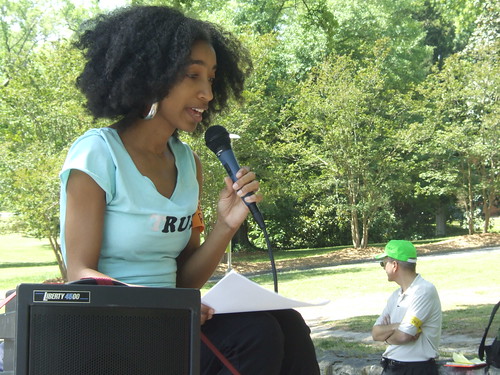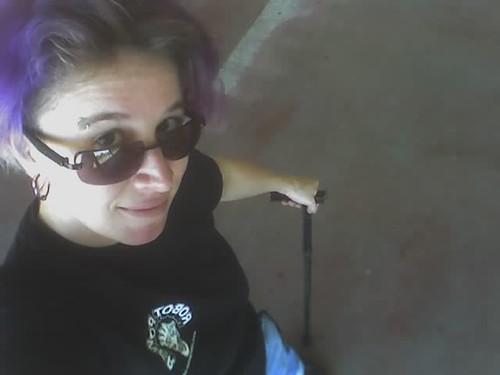This afternoon we drove around searching for the building I’ve seen and wondered about for years. It’s visible from Highway 101, is topped with giant panels of stained glass, and says “STUDIO” on the side in white letters. “Studio” is not very google-able. It’s in a neighborhood in San Francisco called Silver Terrace, just west of Bayview and east of Portola. STUDIO, after we tracked it down and did some sleuthing, turns out to be Church Art Glass Studio owned (or formerly owned?) by Nick Lukas. Above the front door there’s an awning made of the same colors of glass as are on top of the building, throwing intense colored shadows. Framed stained glass panels were in the dusty windows. The hill was very green & lush. I love corners of neighborhoods that are mostly full of industrial buildings and warehouses for floor tile and stuff like that. This area has the added bonus of being mostly underneath a highway.
The majority of windows at St. Michael [in Livermore, CA] were done by the Church Art Glass Studio of San Francisco, which has designed windows for the churches on the West Coast and Hawaii since the turn of the century. The original owner, Edward Lopolka, advertised as “artists in stained glass, German and English antique.” The business was sold in the 1940’s to the father of Nick Lukas, who continues to operate the business in the shadow of the 280 freeway.
I felt like I solved a mystery only to come up with several more mysteries.
Mystery #1: Is the Studio still open? It looked deserted. A post from 2009 says Lukas was trying to sell his entire stock of art glass. It looks like we only just barely missed a very cool art show hosted there, Virtuoso.
Mystery #2: What is the hill of Silver Terrace called? It doesn’t seem quite like it would be named “Silver Terrace” but that’s what I’m going to have to call it. (ETA: I think it’s Mount St. Joseph! Source: How Many Hills are in San Francisco?
Mystery #3: What is that funky deserted building at 432 Paul Avenue that looks like an old school next to an equally funky factory? It’s beautiful!
Silver Terrace was in the Rincón de las Salinas and Potrero Viejo Mexican land grants, sold off by the Bernal family in the 1860s. Actually it sounds like General Sherman foreclosed on the Bernal mortgage and then sold it off to J.S. Silver who subdivided it into lots, so it’s a very old San Francisco neighborhood. You can see from old maps that Bernal Hill is on one side of the bay inlet where Islais Creek was, that was eventually filled in to become Bayview, and the mystery hill that isn’t called Silver Terrace is on the other side, just east of Hunters Point Ridge.
Here is a fantastic history of the area!
History of Bayview and Hunters Point (pdf)
We ended up going through McLaren Park which we had looked up beforehand – making fun of videos of hippies dancing to very boring music at Jerry Garcia auditorium – And pausing to look out over the valley below & trying to figure out what everything was. It was mostly Visitacion Valley, Bayshore, and the Cow Palace. I’ve never been there. We drove through and the most I can say for it is that I plan on going back to the huge Savers thrift store on Geneva. If there was a there there in Visitacion Valley I didn’t find it. I did wonder about what the Visitation was – something like the Annunciation which I do know is when Mary finds out she’s preggers – It turns out it’s when Mary’s pregnant and knows it, and goes off for a visit with another pregnant lady. I could rewrite that in my head to be all about pregnant ladies being supportive of each other instead of all the stuff about creepy babies leaping in the womb because of getting weird telepathic messages from other babies!
Back on Mission in the Excelsior neighborhood we were tempted by the Chicken Coop restaurant which looked amazingly retro. I couldn’t park though so we decided to go home and make omelettes. Signs informed me that Excelsior Welcomes the World. I will definitely return to work my way through all the small grocery stores on Mission. They look great. Anyway, we changed our minds about dinner again a few blocks later when we passed Joe’s Cable Car. Joe’s Cable Car turned out to be not the greasy cheap diner I thought it was. It is more the Dr. Bronner’s of Burgers. Everything at our table was covered in rambling, old-school sales talk and folksy wisdom about the magic of GROUND STEAK from, presumably, Joe. By the time we ordered our food I couldn’t bring myself to say the word “burger” because of the incredible amount of text about GROUND STEAK I had just read and all about the sharp knives, the way they butcher it all and grind it right there practically at your table, and how Joe himself and his jolly butchers were ready to Down-Home-ily bring a cow right to your house straight from the Gold Rush, and grind it up, unlike the evil fast food industry and its evil, evil breadcrumbs and midwest factory slaughterhouses, so please fork over 14 bucks for your Ground Steak while you enjoy the wolf-whistle of the doorbell and the singing santa christmas lights and the giant neon signs shaped like the Golden Gate Bridge, while sitting in something that in 1965 used to either be, or look like, a cable car. I had a great time and the burger was delicious.
The myth of the place and what I was about to eat had completely sold me on the restaurant before I had even sipped my coke. It was overwhelming especially to sensitive, neurotic artists who had gone to look for America and been driving around all day. It reminded me a little of the 1000 mile trip I took around the Southwest where through three states I saw billboards advertising “The Thing!” and then finally got to “The Thing!” roadside attraction and was so freaked out by its Americana-ness that I wrote several chapters of an autobiographical novel about it.
As usual, Oblomovka navigated and looked things up on his G2 while I drove and made a lot of spontaneous decisions which way to go, and we made things up about the stuff we were looking at and tried to imagine everything about all the neighborhoods and imagined our future hacker artist co-ops in all the funky old buildings. I have an especially good time because we can both get passionately attached to some imaginary and pointless goal, like figuring out where the headwaters of some cemented-over creek is, or how to get as close to the top of a hill as we can, but we don’t actually care that much and so are happy to change our minds and do something else as soon as what we’re doing isn’t fun anymore.
















